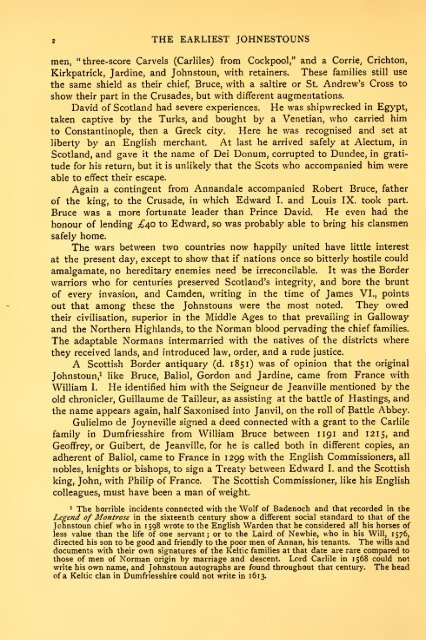History of the Johnstones, 1191-1909, with ... - Electric Scotland
History of the Johnstones, 1191-1909, with ... - Electric Scotland
History of the Johnstones, 1191-1909, with ... - Electric Scotland
Create successful ePaper yourself
Turn your PDF publications into a flip-book with our unique Google optimized e-Paper software.
2<br />
THE EARLIEST JOHNESTOUNS<br />
men, "three-score Carvels (Carliles) from Cockpool," and a Corrie, Crichton,<br />
Kirkpatrick, Jardine, and Johnstoun, <strong>with</strong> retainers. These families still use<br />
<strong>the</strong> same shield as <strong>the</strong>ir chief, Bruce, <strong>with</strong> a saltire or St. Andrew's Cross to<br />
show <strong>the</strong>ir part in <strong>the</strong> Crusades, but <strong>with</strong> different augmentations.<br />
David <strong>of</strong> <strong>Scotland</strong> had severe experiences. He was shipwrecked in Egypt,<br />
taken captive by <strong>the</strong> Turks, and bought by a Venetian, who carried him<br />
to Constantinople, <strong>the</strong>n a Greek city. Here he was recognised and set at<br />
liberty by an English merchant. At last he arrived safely at Alectum, in<br />
<strong>Scotland</strong>, and gave it <strong>the</strong> name <strong>of</strong> Dei Donum, corrupted to Dundee, in gratitude<br />
for his return, but it is unlikely that <strong>the</strong> Scots who accompanied him were<br />
able to effect <strong>the</strong>ir escape.<br />
Again a contingent from Annandale accompanied Robert Bruce, fa<strong>the</strong>r<br />
<strong>of</strong> <strong>the</strong> king, to <strong>the</strong> Crusade, in which Edward I. and Louis IX. took part.<br />
Bruce was a more fortunate leader than Prince David. He even had <strong>the</strong><br />
honour <strong>of</strong> lending £40 to Edward, so was probably able to bring his clansmen<br />
safely home.<br />
The wars between two countries now happily united have little interest<br />
at <strong>the</strong> present day, except to show that if nations once so bitterly hostile could<br />
amalgamate, no hereditary enemies need be irreconcilable. It was <strong>the</strong> Border<br />
warriors who for centuries preserved <strong>Scotland</strong>'s integrity, and bore <strong>the</strong> brunt<br />
<strong>of</strong> every invasion, and Camden, writing in <strong>the</strong> time <strong>of</strong> James VI., points<br />
out that among <strong>the</strong>se <strong>the</strong> Johnstouns were <strong>the</strong> most noted. They owed<br />
<strong>the</strong>ir civilisation, superior in <strong>the</strong> Middle Ages to that prevailing in Galloway<br />
and <strong>the</strong> Nor<strong>the</strong>rn Highlands, to <strong>the</strong> Norman blood pervading <strong>the</strong> chief families.<br />
The adaptable Normans intermarried <strong>with</strong> <strong>the</strong> natives <strong>of</strong> <strong>the</strong> districts where<br />
<strong>the</strong>y received lands, and introduced law, order, and a rude justice.<br />
A Scottish Border antiquary (d. 1851) was <strong>of</strong> opinion that <strong>the</strong> original<br />
Johnstoun, 1 like Bruce, Baliol, Gordon and Jardine, came from France <strong>with</strong><br />
William I. He identified him <strong>with</strong> <strong>the</strong> Seigneur de Jeanville mentioned by <strong>the</strong><br />
old chronicler, Guillaume de Tailleur, as assisting at <strong>the</strong> battle <strong>of</strong> Hastings, and<br />
<strong>the</strong> name appears again, half Saxonised into Janvil, on <strong>the</strong> roll <strong>of</strong> Battle Abbey.<br />
Gulielmo de Joyneville signed a deed connected <strong>with</strong> a grant to <strong>the</strong> Carlile<br />
family in Dumfriesshire from William Bruce between 1 191 and 121 5, and<br />
Ge<strong>of</strong>frey, or Guibert, de Jeanville, for he is called both in different copies, an<br />
adherent <strong>of</strong> Baliol, came to France in 1299 <strong>with</strong> <strong>the</strong> English Commissioners, all<br />
nobles, knights or bishops, to sign a Treaty between Edward I. and <strong>the</strong> Scottish<br />
king, John, <strong>with</strong> Philip <strong>of</strong> France. The Scottish Commissioner, like his English<br />
colleagues, must have been a man <strong>of</strong> weight.<br />
1 The horrible incidents connected <strong>with</strong> <strong>the</strong> Wolf <strong>of</strong> Badenoch and that recorded in <strong>the</strong><br />
Legend <strong>of</strong> Montrose in <strong>the</strong> sixteenth century show a different social standard to that <strong>of</strong> <strong>the</strong><br />
Johnstoun chief who in 1598 wrote to <strong>the</strong> English Warden that he considered all his horses <strong>of</strong><br />
less value than <strong>the</strong> life <strong>of</strong> one servant; or to <strong>the</strong> Laird <strong>of</strong> Newbie, who in his Will, 1576,<br />
directed his son to be good and friendly to <strong>the</strong> poor men <strong>of</strong> Annan, his tenants. The wills and<br />
documents <strong>with</strong> <strong>the</strong>ir own signatures <strong>of</strong> <strong>the</strong> Keltic families at that date are rare compared to<br />
those <strong>of</strong> men <strong>of</strong> Norman origin by marriage and descent. Lord Carlile in 1568 could not<br />
write his own name, and Johnstoun autographs are found throughout that century. The head<br />
<strong>of</strong> a Keltic clan in Dumfriesshire could not write in 1613.

















